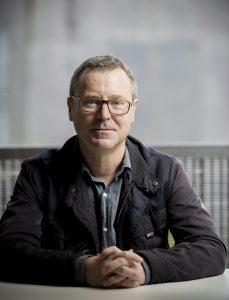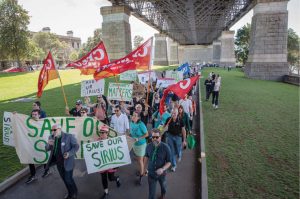NSW Chapter President, Andrew Nimmo
25 September 2017
Last week I chaired a Tuesdays at Tusculum session – The Green Bans – 40 years on: where does the profession stand today?
The speakers were:
- Jim Colman (architect, planner and author of The House That Jack Built – Jack Mundey: Green Bans Hero);
- Sharon Veale (Partner and Chief Executive, GML Heritage);
- James Weirick (Professor of Landscape Architecture & Director, Urban Development & Design Program, University of New South Wales;
- Jocelyn Jackson (Practice Director, TKD Architects and recipient of the 2017 Marion Mahony Griffin Award); and
- Kurt Iveson (Associate Professor of Urban Geography, University of Sydney).
The answer to the question posed by the session depends on where you stand on the heritage – development spectrum.
There has been substantial progress on the regulatory front. Over 1,650 items are listed on the State Heritage Register and 20,000 at the local government level. The Heritage Act provides a process for managing changes to State items through the referral of development applications to the Heritage Council or its delegates; a similar process applies to local items through the Environmental Planning & Assessment Act.
But are we really that much better off keeping and protecting the things that really matter to us as a community? Do the professions help or hinder the process? James Weirick gave a passionate critique of professionally prepared heritage impact statements that smooth the path to the inevitable loss of our collective heritage instead of making bold statements to defend and protect heritage significance. Usually the interests of the development project win in the end, particularly if it is being promoted by the NSW Government.
In this column, I have previously berated the State Government for its signal to ‘the rest of the community, particularly the private sector, that heritage protection is of no value if it prevents the owner from reaping a financial windfall from the sale of the site’. This was my response to the then Heritage Minister’s refusal to consider the listing of the Sirius building on the State Heritage Register.
This criticism applies equally to the heavy-handed approvals process for State significant development and infrastructure. How did we lose a substantial proportion of the unique Federation estate of Haberfield to the WestConnex, an out of date 60s expressway that is being made up as the project ‘moves forward’? What does this say about our values as a society?
Jim Colman reminded us that the notion of the public interest is now so discredited that opposing parties in a dispute will claim it as their guiding principle while cheerfully converting the public domain into private space. But the public interest should be of supreme importance to us as we adjust to the pressures of an increasing population and higher density in the built environment.
Where should the Institute stand in this debate? Public advocacy is fundamental to our role as a professional organisation. The objective in our submissions is to address the process through which the proposal has been put forward, to advocate for good design and to strongly defend the public interest and the public domain. And whilst we must never unfairly criticise the work of our fellow members, it is reasonable at times to question the drivers and outcomes of specific projects. This requires sensitivity and respect for our fellow professionals, along with honest and transparent communication.
This was how we have approached major heritage and development issues during my term as President – Sirius, North Parramatta Urban Transformation, the proposed move of the Powerhouse Museum to Parramatta and the Metro Martin Place unsolicited proposal.
But what about more overt advocacy? Kurt Iveson assured us that, while the weakening of union power means that a Green Bans protest strategy is unlikely to return, it is still possible to create coalitions of interest groups around a particular issue. Social media also has an unrivalled capacity for quick responses from a diverse range of people sharing similar values. The brilliant crowdfunding campaign for the Sirius court case shows how that can work.
Sirius itself is a beacon, demonstrating through its continuing imperilled existence both the similarities and the differences between the 1970s and now. From its design and construction as custom-built housing for local residents who would otherwise have been thrown on to the streets, the building has become a celebration in physical form of the Green Bans campaigns and their beneficial impact on the physical fabric of the city.
Then this year the Sirius non-decision was the reason why the Land & Environment Court made its judgment that the Heritage Act had been misused by the government that administers it.
Forty years after the period of public activism that led to the Heritage Act and the construction of Sirius, they were intertwined in a symbolic confirmation of the Act and the public interest it defends.
But symbols take us only so far. When State Treasurers become architectural and cultural critics, as Dominic Perrottet did in the Daily Telegraph following the court decision, you know that the struggle to save Sirius and our 20th century architectural legacy is far from over. The culture wars are alive and well in 2017.
For those of you who are too young to understand the significance of the Green Bans, I encourage you to read Jim Colman’s book, The House That Jack Built – Jack Mundey: Green Bans Hero. It is an excellent primer on urban activism that actually made a difference.
The September 2016 march in support of Sirius.
Photo: Craig Hayman
Finally, I would like to confirm that the NSW Chapter Council have overwhemingly agreed to express their support for marriage equality. I leave you with the words of our very own GET:
“Equal opportunity is a core value of the Gender Equity Taskforce. Diversity enriches our lives, the profession and society at large. In solidarity with the LGBTQ community, vote yes and join us in building a more inclusive future.
GET:behind marriage equality”
… and get voting!



